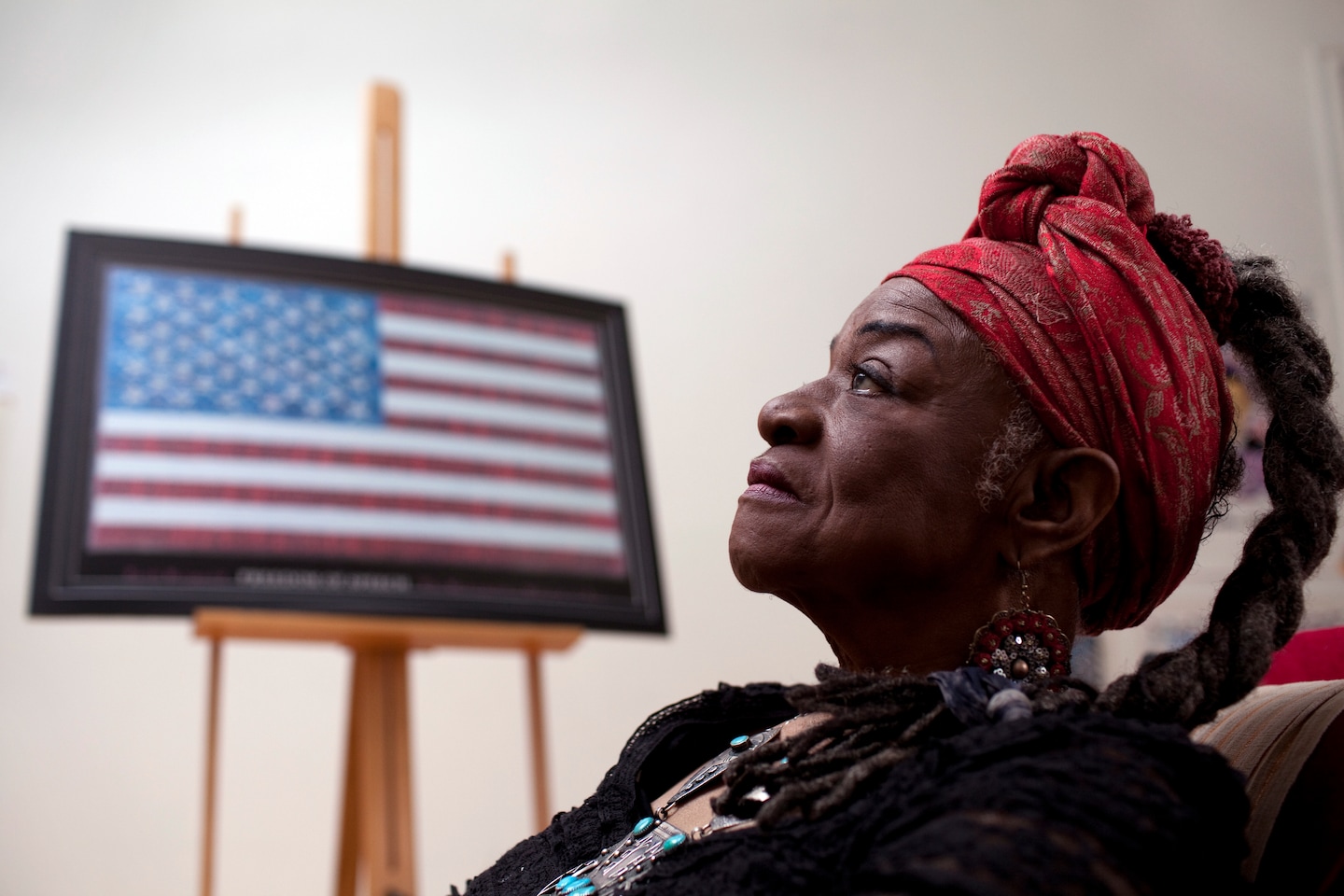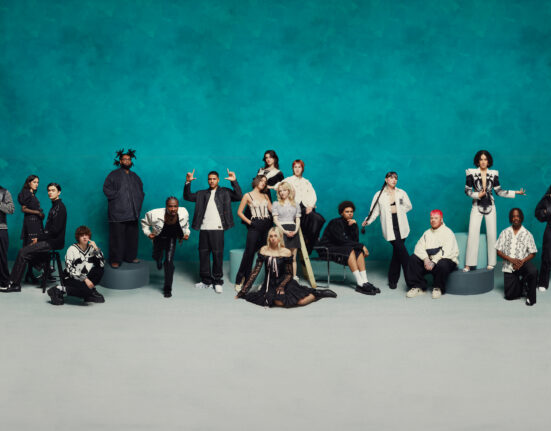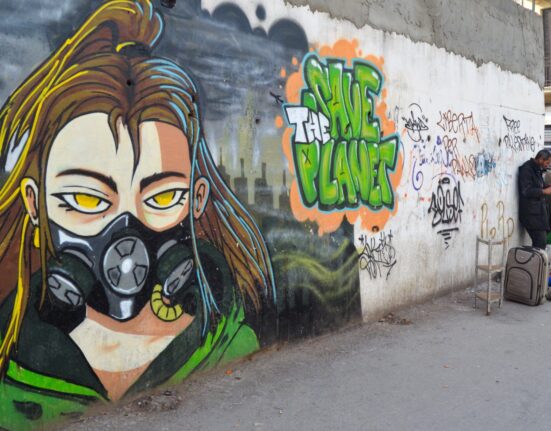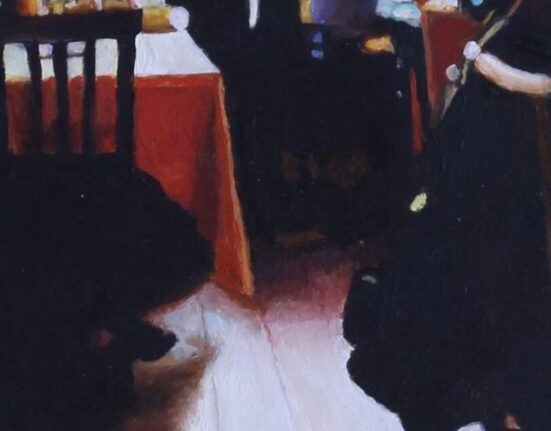Her assistant, Grace Matthews, confirmed the death but did not give a cause.
A protean and prolific artist who reinvented herself multiple times, Ms. Ringgold bucked trends and conventions throughout her six-decade career. She made figure paintings and politically incendiary work in an era when abstraction was in vogue; championed racial justice and feminism even when those causes put her at odds with curators; and pursued art forms that were often consigned to the domestic sphere, making playful and evocative “story quilts” that combined texts and images, serving as an extension of her paintings.
“The fact that I’m considered a minority on every count frees me to do what I want to do,” she told the New York Times in 1984. “I believe in being an artist as a way of life; my intention is serious, and I’m ready to challenge anyone who says what I do isn’t.”
For years, Ms. Ringgold worked on the margins of the mainstream while also trying to reshape art-world institutions. Beginning in the late 1960s, she helped organize demonstrations against the Museum of Modern Art and the Whitney Museum of American Art in New York, calling for women and Black artists to be better represented in shows and collections.
She and her allies notched a few victories — after they staged demonstrations at the Whitney, placing tampons and uncooked eggs in galleries and stairwells, the museum’s annual sculpture show featured a greater number of women — although it would be almost 50 years before Ms. Ringgold received a flurry of late-in-life recognition for her own work, amid a wider reckoning with sexism and racial injustice.
Reviewing a 2019 retrospective of her work at the Glenstone museum in Potomac, Md., Washington Post art critic Philip Kennicott wrote that “Ringgold emerges not just as a powerful advocate for racial justice and the equality of women, but as a prophet. And seeing a cross-section of the 90-year-old artist’s career leaves one thrilled by something else as well: the cohesiveness and persistence of her ideas, impulses and gestures, which suggests a heroic sense of purpose, a mind dedicated to gathering things up, binding them together and making them legible to as wide an audience as possible.”
Ms. Ringgold was hardly known for provocative work at the outset of her career, when she supported herself with a job as a New York City public school teacher while painting landscapes. But after encountering the work of Black authors and activists such as James Baldwin and Amiri Baraka in the mid-1960s, she began tackling political subject matter in her “American People” series, which evoked the racial tensions and unrest of the era in large-scale works like “The Flag Is Bleeding.”
Completed in 1967, the canvas juxtaposed a blood-soaked American flag with the image of three figures linked arm in arm: a White man, a White woman and a Black man, who grips a knife with his left hand and holds his right hand over his heart, where blood oozes from his chest.
That same year, as race riots broke out in cities across the country, Ms. Ringgold finished another mural-sized painting in the “American People” series, “Die” (1967), which showed a dozen blood-spattered Black and White figures dressed in suits and cocktail attire, fighting and collapsing on the sidewalk. “I was just trying to read the times,” she later said, “and to me everyone was falling down.”
Other paintings were more joyful and abstract. Ms. Ringgold ditched the color white and experimented with darker shades for portraits in her “Black Light” series, and dispensed with figurative shapes altogether in her kaleidoscopic 1980s series “Dah,” which she named after a nonsense word her baby granddaughter used to refer to the pictures.
During a visit to the Rijksmuseum in Amsterdam, Ms. Ringgold discovered a collection of thangkas, Tibetan Buddhist paintings made on cotton and silk. The pieces appealed to her in part because of their convenience — she could roll them up when they weren’t hung vertically on a wall — and launched her on a new phase of her career, inspiring her to make thangkas of her own and eventually to focus on quilts.
Collaborating with her mother, Willi Posey, Ms. Ringgold made her first painted quilt, “Echoes of Harlem,” in 1980, drawing on memories of her childhood in the New York City neighborhood. The quilt featured a tapestry of 30 faces, painted on cotton, and laid the groundwork for her story quilts, which were hung on gallery walls and combined elements of fiction and autobiography in lengthy blocks of text.
While her enslaved ancestors had once made quilts for plantation owners, Ms. Ringgold helped elevate the quilt into high art through playful and subversive works such as “Who’s Afraid of Aunt Jemima?” (1983), which reimagined the syrup brand mascot as an independent-minded entrepreneur instead of a racist archetype. Other quilts suggested an almost childlike sense of wonder and yearning, as in “Tar Beach” (1988), which told the story of a young girl named Cassie who passes the time on “tar beach,” the roof of her Harlem apartment building, where she dreams of taking flight and soaring above the city.
The quilt was inspired by Ms. Ringgold’s own childhood and led her to publish her first book, also called “Tar Beach” (1991). A runner-up for the Caldecott Medal for best American picture book, it launched Ms. Ringgold on a new career as an author and illustrator, leading to picture books about the Harlem Renaissance and Rosa Parks, among other subjects, even as she remained best known for “Tar Beach.”
By the book’s end, Cassie has soared above the George Washington Bridge near her home. Anyone can fly, she tells her brother: “All you need is somewhere to go you can’t get to any other way. The next thing you know, you’re flying above the stars.”
The youngest of three children, Faith Willi Jones was born in Harlem on Oct. 8, 1930. Her father, who left the family when she was young, drove a sanitation truck and was said to have scavenged her first easels while doing his rounds. Her mother was a seamstress and fashion designer.
Ms. Ringgold turned to art while struggling with asthma as a young child. She received early encouragement from neighbors in Sugar Hill, a popular area for Black artists, musicians and professionals, where she lived on the same block as saxophonist Sonny Rollins and was down the street from Duke Ellington and the tap-dancing Nicholas Brothers.
While studying art and education at the City College of New York, she married Robert Earl Wallace, a pianist, in 1950. They had two children, separated after four years and later divorced. In 1962, she married Burdette “Birdie” Ringgold, who worked at an automobile plant in New Jersey.
Ms. Ringgold received a bachelor’s degree in 1955, followed by a master’s in art from City College in 1959. She held her first New York solo show at Spectrum Gallery in 1967 and received early encouragement from the gallery’s director, Robert Newman, who offered up the venue’s vacant space during the summer for her to focus on her large-scale works.
Within a few years, Ms. Ringgold had broadened her advocacy to feminist and antiwar issues. She was briefly jailed in 1970, when she helped organize an exhibition of flag art, designed to test a New York state law prohibiting the desecration of the American flag. With allies that included her daughter Michele Wallace, an author and cultural critic, she also co-founded a short-lived advocacy group, the National Black Feminist Organization.
In addition to Michele, survivors include another daughter, Barbara Wallace; three granddaughters; and three great-grandsons. Her husband died in 2020.
After working as a public art teacher for nearly 20 years, Ms. Ringgold joined the University of California at San Diego in 1984, where she was an art professor until her retirement from teaching in 2002. She was still working in recent years, and was delighted by the belated recognition for her work, especially the more political paintings from the 1960s, which viewers seemed to lose interest in after the decade ended.
“There are very many artists who just want to paint colors. That’s fine. I couldn’t do that,” she told NPR in 2013, discussing the role that activism and advocacy played in her work. “I have something else I want to make my story about. And I need the freedom to do that.”







